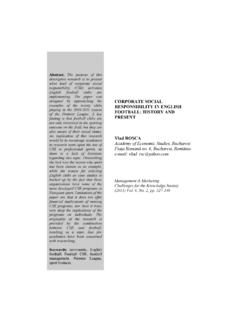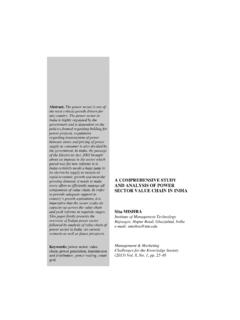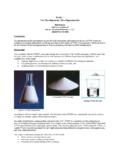Transcription of STRUCTURAL ANALYSIS OF ENGINEERING …
1 Abstract. Strategic management models have been evolving in the business domain on a continuous basis but the overwhelming majority of works in this field gives the impression that it is only the manufacturing industry that needs strategy and strategic models, or that the strategy in the professional services industry is the same as in the manufacturing industry despite their distinctive characteristics and managerial implications. By using the Porter s Five Forces framework for industry ANALYSIS , which evaluates a certain industry based on five parameters each focusing on different challenges a company can potentially face with, the paper aims at analyzing the strategic landscape of ENGINEERING consulting and design companies. The purpose of this paper is to discuss an interpretation and adaptation of Porter s Five Forces model to professional services industry, and in particular to ENGINEERING consulting and design industry. Keywords: professional services firms (PSFs), industry ANALYSIS , ENGINEERING consulting and design companies (ECDCs).
2 STRUCTURAL ANALYSIS OF ENGINEERING consulting AND DESIGN INDUSTRY Gabriel Sorin STROE UZINSIDER ENGINEERING Gala i 2, Sm rdan Street, Gala i, Rom nia e-mail: Management & Marketing Challenges for the Knowledge Society (2013) Vol. 8, No. 1, pp. 41-62 Management & Marketing 421. Introduction Strategic management models have been evolving on a continuous basis since the late nineteenth century but the overwhelming majority of works in this field gives the impression that there are only the manufacturing or services industries that need strategy and strategic models, or that the strategy in the professional services industry ( Professional ENGINEERING consulting and Design Services) is the same as in the manufacturing industry despite their distinctive characteristics, managerial implications and organizational responses. By using the classic framework for industry ANALYSIS known as Porter s Five Forces, which evaluates a certain industry based on five parameters, the paper aims at analyzing the general and most common competitive landscape and adapting Porter s model for the case of the ENGINEERING consulting and Design Industry.
3 The ENGINEERING consulting and design, although it is a niche industry, cannot be viewed in isolation since the industry s structure and trends are influenced by a wider range of stakeholders, encompassing clients, higher education institutions, supply industries, professional and trade associations. The ANALYSIS in this report is supported by the general literature on Professional Services Firms (PSFs), scarce literature on ENGINEERING firms, also by author s own practicing experience of more than 20 years in the consulting and ENGINEERING design industry, both as a design engineer also as a general manager of an ENGINEERING company. The ANALYSIS can be characterized as a descriptive one, starting with a general overview of the ENGINEERING consulting and design industry, containing a literature survey on the specific characteristics of ENGINEERING consulting and Design Companies ECDCs (common with those of PSFs) and a description and classification of the ENGINEERING consulting and design services, and then continuing with an introduction of Porter s Five Forces framework adapted for the specific case of ENGINEERING consulting and design industry.
4 The paper ends up with a set of conclusions and managerial implications, also with a set of proposed directions for further research on the industry. 2. ENGINEERING consulting and design industry a general overview Within the Professional Services Firms (PSFs) sector, ENGINEERING consulting and design companies (ECDCs) are among the least studied entities (Rimmer, 1991). However, in the international management literature there can be found some books and papers approaching narrow and distinct directions of study such as characterization of consulting and ENGINEERING design organizations in developing countries (Ar oz, 1981; Malhotra, 1976; Kamenetzky, 1976), exploratory empirical study of the international consulting ENGINEERING design services industry from an perspective (Stanbury, 1992), strategic management in ENGINEERING organizations (Chinowsky and Meredith, 2000; Chinowsky, 2001; Veshosky, 1994), operational STRUCTURAL ANALYSIS of ENGINEERING consulting and design industry 43strategy, flexibility and performance (Aranda, 2003), knowledge creation and management (Baark, 2002), pricing of ENGINEERING services (Farr, 2001; Stasiowsky, 1993.)
5 Sturts and Griffis, 2005), product design (Hales and Gooch, 2004; Reinertsen, 1997), costs control ENGINEERING design organizations (Pellicer, 2005), marketing practices and strategies of ENGINEERING design firms (Jaafar et al., 2008; Maliti, 2010; Shearer, 1990), critical success factors (Koutsikouri, 2006), impact of diversity, experience, compensation of human capital on firm performance (Laursen et al., 2005), relationship between intellectual capital and business performance (Huang and Hsueh, 2007), and the learning process during customer relationship (Salmi et al., 2005). The ECDCs, among others of the same knowledge-based and professional type, are worthy of attention since they played and are still playing an important role in the economic growth of countries in the world today. That they have been unnoticed so far is probably because they are so obscure, small and hidden in statistics as services or, in the best case, as professional services companies.
6 As ECDCs belong to the PSFs category which in its turn is a sub-group of the Knowledge-Intensive Firms (KIFs) or Know-How Companies group, the following mutual characteristics of these types of companies relevant for the present ANALYSIS are presented (L wendahl, 2005; Sveiby and Lloyd, 1987; Alvesson, 1995, 2004; Scott, 1998): Their business consists in creative, complex, and customized problem-solving. Most projects performed are prototypes. Hence, production processes are not easily industrialized. There is an informational asymmetry between the professional service provider (ECDC) and customer, which often favors the former over the latter. Both their inputs and outputs are intangible. For professional workers (engineers, designers) knowledge is simultaneously an input, medium and output of their work (Newell et al., 2002) and is characterized by a high degree of intangibility.
7 Even though for ECDCs the outputs are in form of studies, drawings, plans, specifications, calculation reports, instructions, which are tangible, storable and reusable, the intangibility of outputs refers in this case to the lack of customers capability to physically feel and assess the outputs because of the lack of specialized knowledge and information. Their key strategic resource is the human capital with its knowledge, competences, capabilities, skills, expertise and experience rather than the financial capital or machines. They build their strengths through highly qualified engineers and designers. Their number of highly qualified professional employees (engineers, designers) doing knowledge-based work out of the total number of employees usually amounts to 80-85% for large-sized firms and 95-100% for medium and small-sized firms. Fixed personnel costs represent about 65-70% of all fixed costs of the company due to professional hiring.
8 Management & Marketing 44 Training and motivation of their professional engineers is the equivalent of what maintenance is for the machines and equipment in the manufacturing companies. Recruitment of highly qualified and experienced engineers and designers is the counterpart of investment in new machines and equipment in a manufacturing company. Their professional workers are the equivalent of the machines in the manufacturing companies. Research and development activities are the counterpart of investments in new products in a manufacturing company. Investments are written off in short periods of time, especially for computer hardware and software that have to be continually renewed in order to stay competitive. The information flow in an ECDC is similar to the flow of materials and goods in the manufacturing companies. The know-how of their personnel, which can only be considered on an invisible balance sheet, counterbalances the fixed assets on the traditional balance sheet of manufacturing companies.
9 Selling consulting and ENGINEERING design services to potential clients is very different from the mass-marketing of consumer goods or services as it involves both interactions with the customer and a high degree of uncertainty in terms of what actually is going to be delivered. Demand of consulting and ENGINEERING design services is regularly characterized by uncertainty, unpredictability, severe fluctuations, stagnation, or even discontinuity over time, depending on the economic cycles and investment policies of the potential customers. ENGINEERING consulting and design services, as highly specialized activities, represent a key knowledge-intensive sector that emerged during a later phase of industrial development when a need for innovative solutions and improved design for construction projects, plants layout and technologies became evident. It has been seen as the key factor in the generation and definition of new technologies in advanced industrial economies and as a key factor in undertaking technology transfer in developing economies.
10 The markets for ENGINEERING consulting and design services are therefore primarily related to the growth of industries (metals, mining, power, oil and gas, heavy machinery, cement, etc.) and construction sector, and business in this industry tends to fluctuate with the cycles of growth and stagnation in manufacturing and production in major markets. ENGINEERING consulting and design services are generally defined as highly specialized activities of intellectual nature, which identify, select, organize and apply technological ENGINEERING knowledge for purposes of investments and production. They are characterized by certain methods/methodologies of work and often by a multidisciplinary approach ( ENGINEERING , architecture, economics, finance, project management, ecology). The ECDCs may provide any or all of a number of services, from consultancy to ENGINEERING , and these services can be categorized according to STRUCTURAL ANALYSIS of ENGINEERING consulting and design industry 45the stage of a project for which the services are provided.







